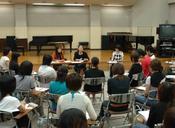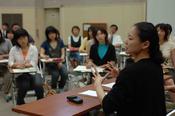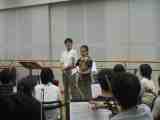July 3, 2005
Last Entry
Dear Doug,
I have enjoyed keeping this blog over the last two weeks. In addition to my concerts and other activities here in Asia, the blog gave me the opportunity to share my thoughts and feelings about these experiences with you and our readers. As is often the case, the impact of these experiences is likely to manifest itself in my future endeavors.
I particularly enjoyed thinking about different ways to form strong partnerships among the relevant parties in concert presentation -- the audience, presenters, and performers. Whether in the East or in the West, I continue to explore ways of keeping music alive and vivid through different presentation methods.
The young violinists in Singapore, the arts management students in Japan, and all the other young people I have encountered in the last two weeks will keep energizing and motivating my future activities.
I look forward to continuing our dialogue informally and to hearing from our readers how they think we can better achieve a more active and involved audience/presenter/artist axis.
With best wishes,
Midori
Posted by at 1:01 PM
July 2, 2005
Rehearsing with Discipline
Dear Doug,
I spent today rehearsing with the Tama Youth Orchestra in preparation for the concert tomorrow afternoon. We are playing Summer from Vivaldi's Four Seasons. The Tama Youth Orchestra is one of four youth orchestras selected by lottery from a pool of applicants to participate in the Music Sharing Special Concert in Tokyo. Other works being performed this year include Beethoven’s First Piano Concerto (with Koji Oikawa, my pianist-partner for all the Music Sharing concerts in Japan), Eval'd's Sinfonia for Five Parts Brass Choir, and Tchaikovsky Symphony No. 1. Each of the works will be performed by a different orchestra and each orchestra has participated in the past in the Music Sharing Orchestra Visiting Program. Besides Tama orchestra and Shirayuri orchestra, which plays the Beethoven, the other two groups are Matsudo Youth Orchestra Brass Ensemble (Eval'd)and the Fuji High School Orchestra (Tchaikovsky).
Music Sharing is my outreach non-profit organization in Japan. The mission is to bring children opportunities to come into direct contact with music, both classical and Traditional Japanese. The Orchestra Visiting Program is currently in its fourth season at Music Sharing. The goal of this program is to facilitate stronger communication between young and professional artists. In Japan, there is a distinction between youth orchestras that are independent organizations and school orchestras that operate as part of after-school programs or "Club" activities. From tomorrow's program, Matsudo and Tama are in the former category whereas the Fuji and Shirayuri are in the latter.
I was impressed, as we rehearsed with the Tama Youth Orchestra, by the respect the students showed toward one another and toward the adults. The concept of respect is still very important here, and it is fascinating to feel the intent gaze of all the musicians each time I open my mouth to make a comment. There is no yawning, no side discussion with the stand partners, no dropping of music.
We spent some time discussing different colors within the music. I am particularly fond of working with harmonic characteristics and acknowledging them as we play them. Another favorite of mine is to be certain where changes occur in music, whether in character, mood, texture, or articulation. When I listen to music, I want to hear when changes occur as they happen, rather than realize, in retrospect, that the changes have taken place.
The Beethoven First Piano Concerto with Koji Oikawa will be performed tomorrow by the Shirayuri Middle School Orchestra from Sendai. This is one of the "Club" orchestras, which rehearses every day after school. In general, the majority of "Club" orchestra members do not have previous experience playing instruments prior to joining the orchestra in contrast with orchestras like Tama Youth Orchestra, which selects its members by audition. The older students in the "Club" orchestras coach the younger ones, and most of them make decisions rather democratically with support from the adults. Though the teachers and staff are present, the daily management of the activities is left up to the students, including decisions about repertoire. The adults take a supportive role and guide them when necessary, but the students are encouraged to make their own decisions through discussions. Some "Club" orchestras have one of the music teachers as the conductor while others may have a fellow student to stand on the podium.
I listened to part of the Shirayuri Middle School Orchestra rehearsal earlier today, as Koji, with the help of the conductor-teacher, did his best to energize the students. The main focus of the rehearsal was on style. At one moment, I had the sense that all the young musicians made a leap from simply "playing" the notes to "feeling" the music. It was amazing to watch how Koji inspired the students and made them light up. They went from being timid about playing all the notes to playing the music with a sense of purpose. I could hear and sense a big change.
I am often asked whether discipline plays a big role in Asian (or Japanese) music education. It certainly makes it easier for teachers to work within a disciplined environment. The sense of focus I feel from the students in Japan is simply amazing. I suppose one could argue that this discipline "cages" the students into a corner, but after my experiences today with the two groups, I did not feel that this was the case.
At the end of the rehearsal with the Tama group, I reinforced some of the issues I had addressed during the rehearsal, and asked the students to give themselves a few minutes to think them over and look over their music markings before rushing to put away their instruments. I got an amazing chorus of "Hai!" meaning "Yes." Then, as I was leaving the rehearsal room, they all stood up, bowed, and thanked me.
Wow. I'm certainly not used to being treated this way!
Midori
Posted by at 4:17 PM
July 1, 2005
Total Experience with the Students
Dear Doug,
In the late 1990s, while studying at Gallatin College of New York University, I was greatly inspired by a performance of the Iphigenia Cycle, directed by JoAnne Akalaitis at New York’s American Place Theater. From the moment the audience entered the theater, we were immersed in the theme of the Trojan War. From the hallways to the bathroom walls, the entire building was arranged in such a way that everything suggested the world of the classical Greek story. It was the importance of the theme that impressed me most, rather than the star actors. This was a very powerful feeling and, when I left the theater, I felt I was stepping out into a completely different world.

After that experience, I tried to think of ways in which similar "theme saturation" might be used to present musical events, including concerts. At the same time, I determined to try to make my concerts into more personal or "individualized” experiences that would link the audience, the presenters and the performers.
As you know, there is background information about the Total Experience Project on my website. The first round took place in Japan in 2003; this is also documented on the website.
This year, for the second round, we chose "Wa" for our theme. “Wa,” roughly translated, means circle, round, cyclic, link, (of a wheel) connection, etc. We decided to work with students of arts management at Niigata University and at the Showa Music College in Atsugi, the first school in Japan to establish an arts management curriculum. The students were initially provided with a description of the concept, the program of my recital and access to background about the Total Experience concept on my website.
Interestingly, students at both schools chose to interpret “Wa” as a “link” or “web of communications” rather than simply as a circle or cycle. Each group of students decided independently to create closer links with their surrounding communities.

In Niigata, which is north of Tokyo, and is where the large earthquake took place last year, students prepared a newsletter called “The Link” that they circulated to members of community, through local amateur orchestras and choirs, to publicize the events leading up to my recital. They held a musical walkathon (Walk-Rally), set up a cello seminar in which they offered a free lesson to those who attended and held a listening session tied to violin repertoire, among others. They asked members of the community to draw on pieces of paper their interpretations of the theme of “Wa” and they linked all the responses in a circular display in the lobby of the recital hall. The students at both schools were responsible for preparing program notes, sending out tickets - only those who participated in the community-based events could apply for tickets-, doing all related artwork, and arranging post concert receptions.
At Showa Music College, the students arranged for their instrumentalist colleagues to give community concerts in shopping malls and other public spaces. They also held a session in which they encouraged participants to explore the acoustic differences between various instruments. Like their Niigata counterparts, they asked members of the community to contribute something showing what “Wa” meant to them and displayed the responses on a bulletin board in the concert hall lobby.
The students at both schools were quite shy at first, but I sense that they got a sense in the process of the project the importance of taking action. The challenge of involving everyone and facilitating communication required more energy and effort that they initially expected. I am hoping that they learned something they can take with them in their future endeavors--as arts managers, presenters, and administrators.
Midori
Posted by at 5:06 PM

